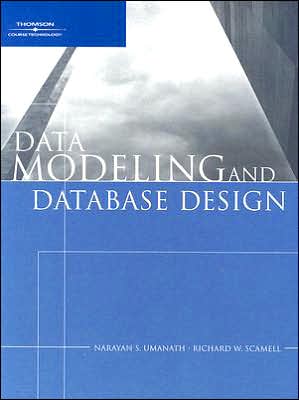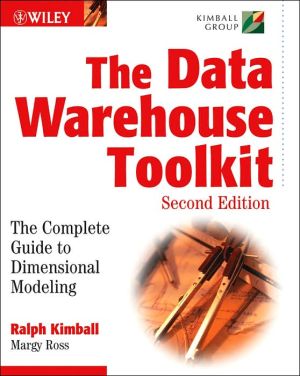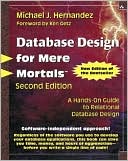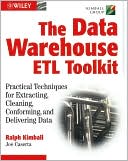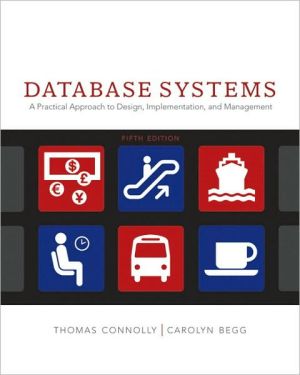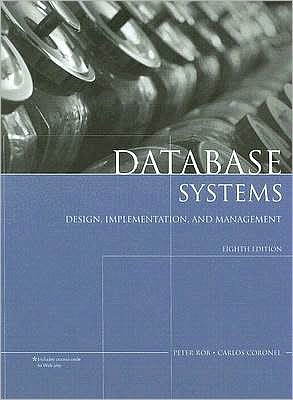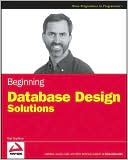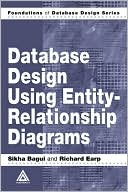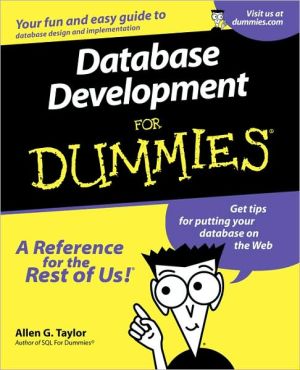Data Modeling and Database Design
Data Modeling and Database Design presents a conceptually complete coverage of indispensable topics that each MIS student should learn if that student takes only one database course. Database design and data modeling encompass the minimal set of topics addressing the core competency of knowledge students should acquire in the database area. The text, rich examples, and figures work together to cover material with a depth and precision that is not available in more introductory database books.
Search in google:
Data Modeling and Database Design presents a conceptually complete coverage of indispensable topics that each MIS student should learn if that student takes only one database course. Database design and data modeling encompass the minimal set of topics addressing the core competency of knowledge students should acquire in the database area. The text, rich examples, and figures work together to cover material with a depth and precision that is not available in more introductory database books.
Preface xvDatabase Systems: Architecture and Components 1Data, Information, and Metadata 1Data Management 2Limitations of File-Processing Systems 3The ANSI/SPARC Three-Schema Architecture 5Characteristics of Database Systems 8What Is a Database System? 10What Is a Database Management System? 11Advantages of Database Systems 13Data Models 14Data Models and Database Design 15The Database Design Life Cycle 16Chapter Summary 19Exercises 20Selected Bibliography 21Conceptual Data ModelingFoundation Concepts 26A Conceptual Modeling Framework 26ER Modeling Primitives 26Foundations of the ER Modeling Grammar 28Entity Types and Attributes 28Entity and Attribute-Level Data Integrity Constraints 30Relationship Types 33Structural Constraints of a Relationship Type 38Base Entity Types and Weak Entity Types 49Data Modeling Errors 54Vignette 1 54Vignette 2 60Vignette 3 61Chapter Summary 68Exercises 69Selected Bibliography 73Entity-Relationship Modeling 75Bearcat Incorporated: A Case Study 75Applying the ER Modeling Grammar to the Conceptual Modeling Process 77The Presentation Layer ER Model 78The Presentation Layer ER Model for Bearcat Incorporated 81The Coarse-Granular Design-Specific ER Model 95The Fine-granular Design-Specific ER Model 106Chapter Summary 113Exercises 113Selected Bibliography 118Enhanced Entity-Relationship (EER) Modeling 119Superclass/subclass Relationship 119Vignette 1 120A Motivating Exemplar 124General Properties of a Superclass/subclass Relationship 125Specialization and Generalization 126Specialization Hierarchy and Specialization Lattice 133Categorization 136Choosing the Appropriate EER Construct 139Aggregation 144Converting from the Presentation Layer to a Design-Specific EER Diagram 146Bearcat Incorporated Data Requirements Revisited 148ER Model for the Revised Story 149Chapter Summary 157Exercises 157Selected Bibliography 162Modeling Complex Relationships 163The Ternary Relationship Type 164Vignette 1-Madeira College 164Vignette 2-Get Well Pharmacists, Inc. 169Beyond the Ternary Relationship Type 171The Case for a Cluster Entity Type 171Vignette 3-More on Madeira College 172Vignette 4-A More Complex Entity Clustering 176Cluster Entity Type-Additional Examples 179Madeira College-The Rest of the Story 182Clustering a Recursive Relationship Type 186The Weak Relationship Type 190Composites of Weak Relationship Types 196Inclusion Dependency in Composite Relationship Types 196Exclusion Dependency in Composites of Weak Relationship Types 197Decomposition of Complex Relationship Constructs 198Decomposing Ternary and Higher-Order Relationship Types 198Decomposing a Relationship Type with a Multi-valued Attribute 200Decomposing a Cluster Entity Type 204Decomposing a Weak Relationship Type 206Validation of the Conceptual Design 209Fan Trap 210Chasm Trap 213Miscellaneous Semantic Traps 216Cougar Medical Associates 221Conceptual Model for CMA: The Genesis 223Conceptual Model for CMA: The Next Generation 228The Design-Specific ER Model for CMA: The Final Frontier 229Chapter Summary 236Exercises 236Selected Bibliography 240Logical Data ModelingThe Relational Data Model 244Definition 244Characteristics of a Relation 245Data Integrity Constraints 247The Concept of Unique Identifiers 248Referential Integrity Constraint in the Relational Data Model 252A Brief Introduction to Relational Algebra 254Unary Operations: Selection ([sigma]) and Projection ([pi]) 254Binary Operations: Union (U), Difference (-), and Intersection ([Characters not reproducible]) 256The Natural Join (*) Operation 258Views and Materialized Views in the Relational Data Model 259The Issue of Information Preservation 260Mapping an ER Model to a Logical Schema 261Information-Reducing Mapping of ER Constructs 261An Information-Preserving Mapping 277Mapping Enhanced ER Model Constructs to a Logical Schema 281Information-Reducing Mapping of EER Constructs 281Information-Preserving Grammar for Enhanced ER Modeling Constructs 289Chapter Summary 296Exercises 298Selected Bibliography 304NormalizationFunctional Dependencies 308A Motivating Exemplar 308Functional Dependencies 314Definition of Functional Dependency 314Inference Rules for Functional Dependencies 315Minimal Cover for a Set of Functional Dependencies 317Closure of a Set of Attributes 322Whence Do FDs Arise? 323Candidate Keys Revisited 324Deriving Candidate Key(s) by Synthesis 325Deriving Candidate Keys by Decomposition 329Deriving a Candidate Key-Another Example 332Prime and Non-prime Attributes 336Chapter Summary 340Exercises 340Selected Bibliography 344Normal Forms Based on Functional Dependencies 345Normalization 345First Normal Form (1NF) 346Second Normal Form (2NF) 347Third Normal Form (3NF) 351Boyce-Codd Normal Form (BCNF) 354Side Effects of Normalization 357Summary Notes on Normal Forms 367The Motivating Exemplar Revisited 369A Comprehensive Approach to Normalization 372Case 1 373Case 2 380Case 3 386Denormalization 391Role of Reverse Engineering in Data Modeling 392Reverse Engineering the Normalized Solution of Case 1 394Reverse Engineering the Normalized Solution of Case 2 399Reverse Engineering the Normalized Solution of Case 3 401Chapter Summary 406Exercises 407Selected Bibliography 416Higher Normal Forms 417Multi-valued Dependency 417A Motivating Exemplar for Multi-valued Dependency 417Multi-valued Dependency Defined 419Inference Rules for Multi-valued Dependencies 420Fourth Normal Form (4NF) 422Resolution of a 4NF Violation-A Comprehensive Example 425Generality of Multi-valued Dependencies and 4NF 428Join Dependencies and Fifth Normal Form (5NF) 429A Note on Domain-Key Normal Form (DK/NF) 434Chapter Summary 435Exercises 435Selected Bibliography 439Database Implementation Using the Relational Data ModelDatabase Creation 444Data Definition Using SQL 444Base Table Specification in SQL/DDL 445Specification of User-Defined Domains 462Schema and Catalog Concepts in SQL/DDL 466Data Population Using SQL 469The Insert Statement 470The Delete Statement 472The Update Statement 474Access Control in the SQL-92 Standard 475The Grant and Revoke Statements 476Some Examples of Granting and Revoking Privileges 477Chapter Summary 486Exercises 487Selected Bibliography 492Data Manipulation: Relational Algebra and SQL 493Relational Algebra 493Unary Operators 496Binary Operators 499Structured Query Language (SQL) 516SQL Queries Based on a Single Table 518SQL Queries Based on Binary Operators 543Subqueries 557Chapter Summary 572Exercises 573SQL Projects 577Selected Bibliography 577Advanced Data Manipulation Using SQL 579Assertions, Triggers, and Views 579Specifying an Assertion in SQL 579Triggers in SQL 585Specifying Views in SQL/DDL 598The Division Operation 601SQL-92 Built-in Functions 604The Substring Function 606The Char_Length (char) Function 608The Trim Function 610The Translate Function 614The Position Function 614Combining the INSTR and SUBSTR Functions 616Some Brief Comments on Handling Dates and Times 617A Potpourri of Other SQL Queries 622Concluding Example 1 622Concluding Example 2 624Concluding Example 3 626Concluding Example 4 626Concluding Example 5 627Concluding Example 6 628Chapter Summary 629Exercises 629SQL Project 1 630SQL Project 2 639SQL Project 3 645Selected Bibliography 652Data Modeling Architectures Based on the Inverted Tree and Network Data Structures 653Logical Data Structures 653Inverted Tree Structure 653Network Data Structure 654Logical Data Model Architectures 655Hierarchical Data Model 656CODASYL Data Model 660Summary 663Selected Bibliography 663Object-Oriented Data Modeling Architectures 665The Object-Oriented Data Model 665Overview of OO Concepts 666A Note on UML 669The Object-Relational Data Model 671Summary 672Selected Bibliography 672Overview of SQL Reserved Words 673SQL Select Statement Features 683Index 689
\ From the Publisher"The writing style is very good compared to other books. Discussion of the content is accompanied by detailed explanation and adequate examples which make these concepts easy to understand." - Jaymeen Shah, Texas State University\ \
